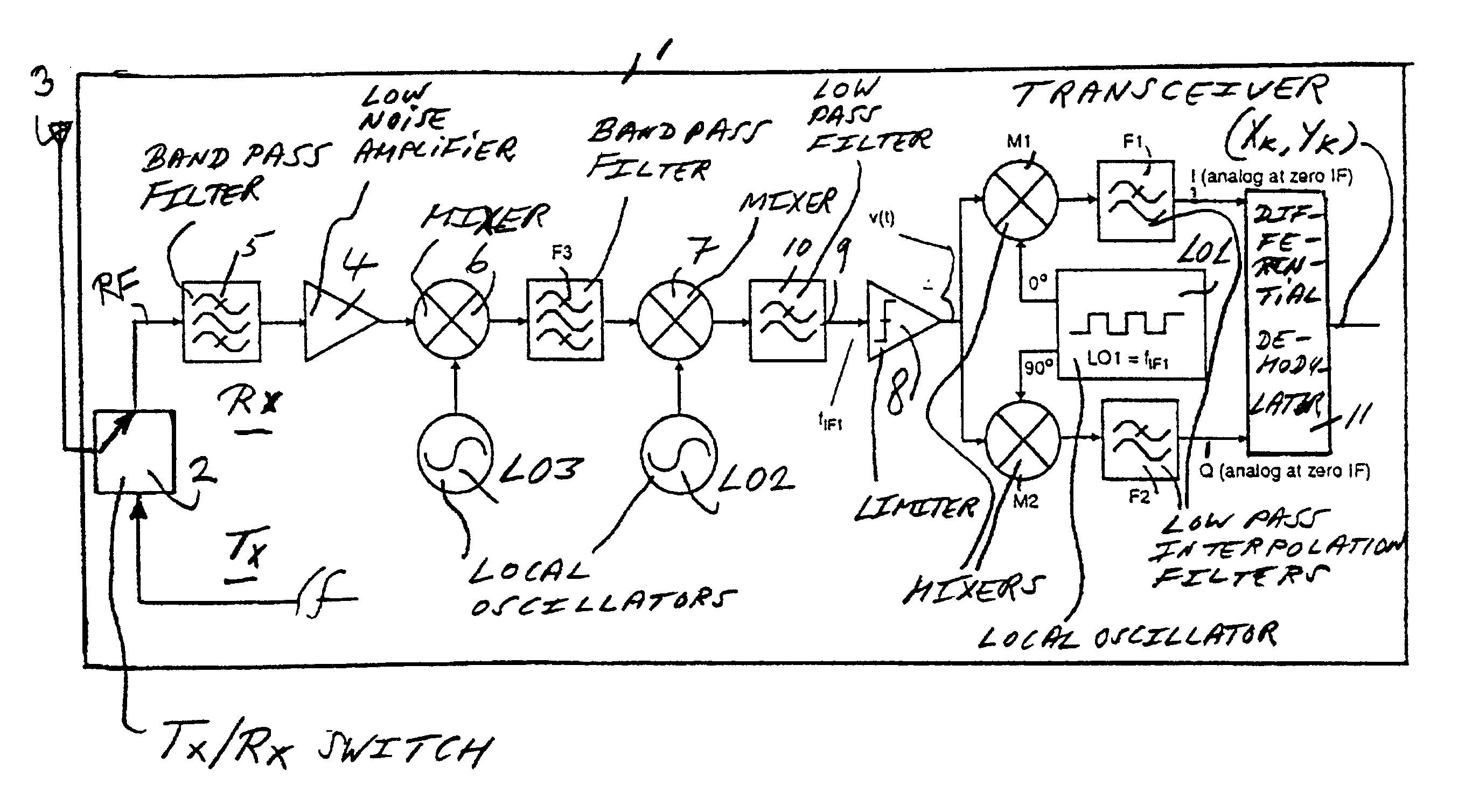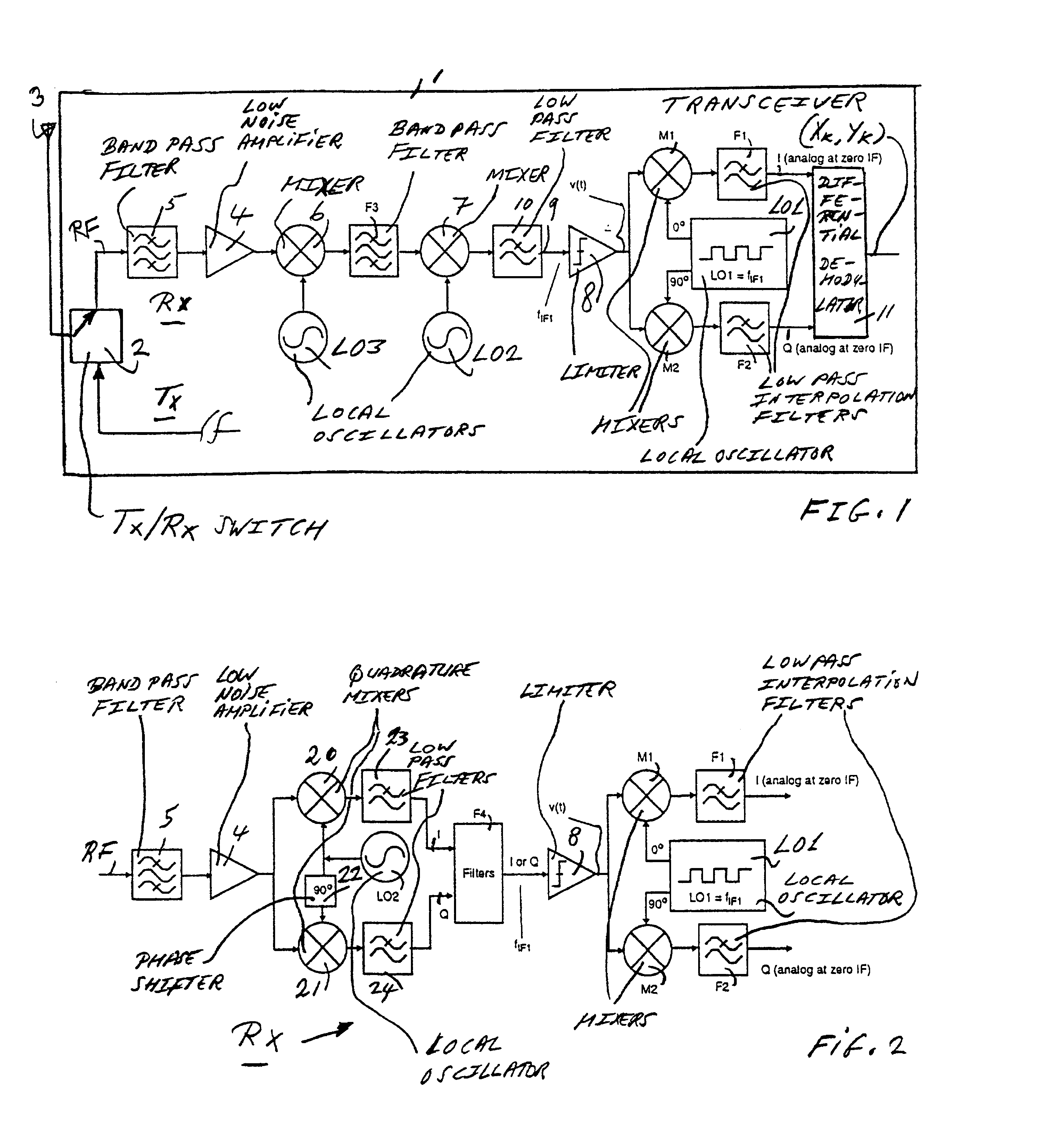Phase interpolation receiver for angle modulated RF signals
a phase interpolation and receiver technology, applied in phase-modulated carrier systems, multi-frequency-changing modulation transference, amplitude demodulation, etc., can solve the problem of complex distributed agcs, limit the dynamic range of channel filters and fm discriminators, and the known zero-if receivers for pwt with /4 dqpsk modulation are even more complicated
- Summary
- Abstract
- Description
- Claims
- Application Information
AI Technical Summary
Benefits of technology
Problems solved by technology
Method used
Image
Examples
first embodiment
[0044]FIG. 1 is a block diagram of a transceiver 1 with a receiver Rx according to the present invention. The receiver Rx is a double super heterodyne receiver with three-step down-conversion from RF to zero-IF or base band. The transceiver, a DECT or a PWT receiver, for instance, comprises a Tx / Rx switch 2 for coupling the receiver Rx to an antenna 3. The Tx / Rx switch 2 is further coupled to a transmit branch Tx that is not shown in detail here. The receiver Rx comprises a low noise RF amplifier 4 that is coupled to the Tx / Rx switch 2 through an RF band pass filter 5. The RF band pass filter 5 receives an angle modulated radio frequency signal RF at the antenna 3. The low noise amplifier 4 is coupled to first down-conversion means, a mixer 6, and a mixer 7, the mixer 6 being coupled to a local oscillator LO3, and the mixer 7 being coupled to a local oscillator LO2. The mixer 6 is coupled to the mixer 7 through a band pass filter F3. The receiver Rx comprises a limiter 8 for a gener...
second embodiment
[0047]FIG. 2 is a block diagram of a receiver according to the present invention. In this embodiment, the receiver Rx is a low-IF receiver with two-step quadrature down-conversion from RF to zero-IF or base band. The receiver Rx comprises a quadrature down-conversion means, quadrature mixers 20 and 21. The mixers 20 and 21 are coupled to the local oscillator LO2, directly and through 90° phase shifter 22, respectively. The mixers 20 and 21 are further coupled to the limiter 8 through a cascade of low pass filters 23 and 24, and poly-phase filters F4.
[0048]In the double superhet receiver Rx of FIG. 1, and in the poly phase receiver Rx of FIG. 2, the noise spreading signal is a very low unwanted 2fIF1 frequency term at the output of the mixers M1 and M2. The hard-limited IF signal is mixed with a square wave LO. This is equivalent to mixing a non-limited IF signal with a sinusoidal LO, and then limiting the signal at the mixer output, as shown in FIG. 3, in which limiters 30 and 31 ar...
PUM
 Login to View More
Login to View More Abstract
Description
Claims
Application Information
 Login to View More
Login to View More - R&D
- Intellectual Property
- Life Sciences
- Materials
- Tech Scout
- Unparalleled Data Quality
- Higher Quality Content
- 60% Fewer Hallucinations
Browse by: Latest US Patents, China's latest patents, Technical Efficacy Thesaurus, Application Domain, Technology Topic, Popular Technical Reports.
© 2025 PatSnap. All rights reserved.Legal|Privacy policy|Modern Slavery Act Transparency Statement|Sitemap|About US| Contact US: help@patsnap.com



